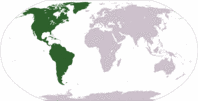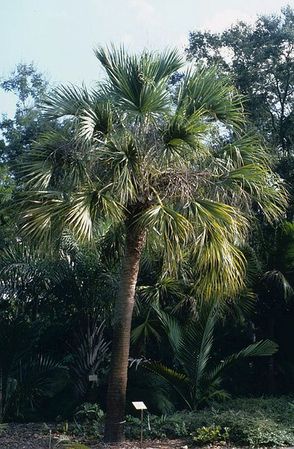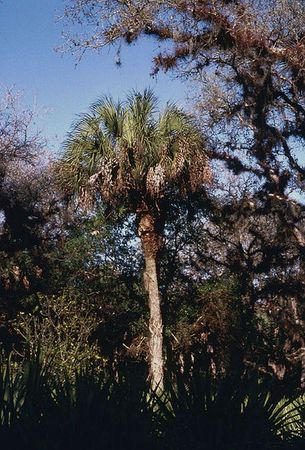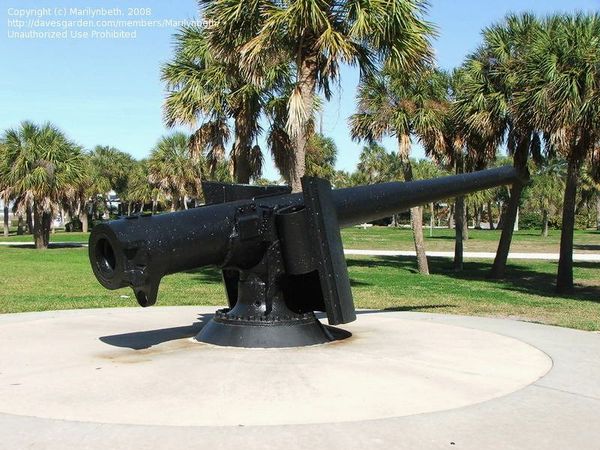Sabal palmetto
| Sabal (SAH-bahl) palmetto (pahl-MEHT-oh) | ||||||||
|---|---|---|---|---|---|---|---|---|
 Fort De Soto, Pinellas County, Florida. Photo by Jason Sharp | ||||||||
| Scientific Classification | ||||||||
| ||||||||
| Synonyms | ||||||||
|
| ||||||||
| Native Continent | ||||||||
|
| ||||||||
| Morphology | ||||||||
| ||||||||
| Culture | ||||||||
| ||||||||
| Survivability index | ||||||||
|
| ||||||||
| Common names | ||||||||
|
| ||||||||
Contents
Habitat and distribution
Sabal palms are New World plants, this species is found in the Bahamas and Cuba, Florida, Georgia and the Carolinas. It thrives in a variety of settings including beaches, forests and swamps. In their natural range they are considered weedy as they readily propagate throughout the landscape, usually assisted by birds.Description
Sabal palmetto, the cabbage palm, is a common inhabitant of scrub communities beyond sand dunes, and the state tree of Florida. It is recognized by its tan-gray, unbranched trunk, and large crown with fanlike leaves. S. palmetto grows to a height of 10 – 25 m (32-82 feet), with a stem diameter of approximately 30 – 60 cm (12-24 inches). (sms.si.edu)
A large robust palm with a solitary trunk, that grows to about 50 ft (15.2 m) but may occassionally reach heights of 70 ft (21.3 m). The crown is relatively small being 12-18 ft (3.7-5.5 m) in diameter. Like many palms the crown is typically wider when grown in shade and more compact when grown in full sun. The large leaves have a dull finish and are a medium green, sometimes yellow-green, in color depending on the individual and situation. Each leaf is up to 12 ft (3.7 m) long overall including the spineless petioles (leaf stems) which measure about 5-6 ft (1.5-1.8 m) in length. They are up to 6 ft (1.8 m) in width with drooping leaf segments about 3 ft (0.9 m) long and 2-3 in (5.1-7.6 cm) wide. These segments are split to about half the width of the leaf and typically slough off tan fibers at the edges. Cabbage palm leaves are costapalmate, meaning that the leaflets are arranged on the stem in a pattern that is midway between palmate (leaflets arranged like the fingers on the palm of your hand) and pinnate (feather shaped). (floridata.com) Editing by edric.
S. palmetto grows to a height of 10 – 25 m (32-82 feet), with a stem diameter of approximately 30 – 60 cm (12-24 inches). Leaves may measure up to 3 m (9.8 feet) in length. Fruits are small, measuring approximately 8 mm (1/3 inch) in width. Root systems are deeply penetrating, and may reach depths of 4.6 – 6.1 m (15-20 feet) (Duncan and Duncan 1988). Stem shape is uniform from the ground to the crown. Leaf bases, also known as boots, tend to slough off the tree as they dry, giving the trunk a smooth appearance (Duncan and Duncan 1988; Walker 1990). Leaves are palmate with no spines, and may measure 3 m (9.8 feet) in length, each with a prominent midrib. Flowers are cream colored and droop in clusters from the crown. Fruits are black and fleshy with a single seed (Olson et al. 1974). They may measure 8 mm (1/3 inch) in width. Root systems are short and bulbous, penetrating the soil to depths of 4.6 – 6.1 m (15-20 feet). (Smithsonian Marine Station at Ft. Pierce)
Culture
Optimum growth occurs in humid subtropical to warm temperate climates where average rainfall is 100 – 163 cm (39-64 inches), and average maximum/minimum temperatures range from –4 - 36° C (25-97 ° F). Northern growth is limited by low winter temperatures. (Smithsonian Marine Station at Ft. Pierce)
Preferred soil type for S. palmetto is calcium rich, and neutral to alkaline in nature. Cabbage palms prefer poorly drained soils, and often grow at the edge of freshwater and brackish wetlands. This species tolerates flooding (Alexander 1955).
Seed Germination: Sabal palm seeds are not difficult to germinate, but should be planted when fresh for best germination. With uniform moisture and high temperatures (86°F–95°F), germination can occur in as few as 18 days, with 50% of final germination occurring within 33 days (Carpenter 1987; Sento 1970). Newly emerged seedlings look much like grass, but each succeeding leaf has an additional leaf segment that adds to their width. The slow-growing seedlings can take 15–30 years to develop a visible trunk under natural conditions, but in nurseries this can occur much faster (McPherson and Williams 1996). Initial trunk elongation can be quite rapid under favorable conditions (up to 6 inches per year), but this quickly slows to less than an inch per year as the palm matures (McPherson and Williams 1996). (edis.ifas.ufl.edu)
Comments and Curiosities
This is a tillering palm, it exhibits saxophone style root growth (it has a heel), keep top third of heel above soil elevation!
Stem shape is uniform from the ground to the crown. Leaf bases, also known as boots, tend to slough off the tree as they dry, giving the trunk a smooth appearance (Duncan and Duncan 1988; Walker 1990). Leaves are palmate with no spines, and may measure 3 m (9.8 feet) in length, each with a prominent midrib. Flowers are cream colored and droop in clusters from the crown. Fruits are black and fleshy with a single seed (Olson et al. 1974). They may measure 8 mm (1/3 inch) in width. Root systems are short and bulbous, penetrating the soil to depths of 4.6 – 6.1 m (15-20 feet). (sms.si.edu)
S. palmetto grows to a height of 10 – 25 m (32-82 feet), with a stem diameter of approximately 30 – 60 cm (12-24 inches). Leaves may measure up to 3 m (9.8 feet) in length. Fruits are small, measuring approximately 8 mm (1/3 inch) in width. Root systems are deeply penetrating, and may reach depths of 4.6 – 6.1 m (15-20 feet). (sms.si.edu)
| read more |
|---|
|
The sabal palm, or cabbage palm, is native to Florida and coastal regions of North and South Carolina and Georgia, and is the state tree of both South Carolina and Florida. The name "cabbage palm" comes from its edible immature leaves, or "heart," which has a cabbage-like flavor. Sabal palms have curved, costapalmate, fan-shaped leaves with blades 3–4 feet long and petioles 3–6 feet long. When free of nutrient deficiencies, this species has a full, round canopy atop a trunk 10–16 inches in diameter and up to 40 feet in height (Figure 1). Branched inflorescences produced during the late spring months usually extend beyond the leaves in the canopy and contain thousands of tiny, creamy-white, fragrant flowers that attract bees. The palm produces black fruits of about ¼ inch in diameter in late summer (Figure 2). Although the fruits contain little flesh, they are often consumed by raccoons and other animals that disperse the seeds. Sabal palms are considered cold hardy to about 15°F, or about USDA Zone 8b (edis.ifas.ufl.edu) South Carolina designated the sabal palmetto (Inodes Palmetto) as the official state tree in 1939. The palmetto symbolizes the defeat of the British fleet at Fort Moultrie on Sullivan’s Island. The fort was constructed of palmetto logs which were able to absorb the impact of cannon balls. Sabal palmetto (commonly called cabbage palm) is a familiar symbol of South Carolina - in fact it's nickname is The Palmetto State. The sabal palmetto is also featured on the state flag, the great seal, and the U.S. Mint's bicentennial commemorative quarter for South Carolina. (statesymbolsusa.org) Phenology: S. palmetto flowers from April through August, depending upon latitude. S. palmetto is insect pollinated. Fruit develops throughout the fall, and ripens in winter. Birds and small mammals that eat the fruit of this tree aid in seed dispersal. Embryology: Fresh fallen seeds are buoyant, and are salt resistant, they require no pretreatment in order to break dormancy. Germination is hastened by planting seeds in moist sand at 3 ° C (38° F) for 30 days. Optimum planting depth is 1.5 – 3 cm (0.5 – 1 inch) in light soil. Seed survival is reported to be low due to consumption by animals. Wade and Langdon (1990) reported that as little as 9% of 620,000 seeds produced per acre survived frugivory. (Smithsonian Marine Station at Ft. Pierce) It is the state tree of South Carolina and Florida. First year growth consists of the primary root, one fully expanded leaf, and a rhizomatous stem (Wade and Langdon 1990). Salinity: Sabal palmetto is highly tolerant of salt spray, and inundation by brackish water. Seeds of this species are also salt resistant (Wade and Langdon 1990). Physical Tolerances: St. John (1973) listed Sabal palmetto as one of the most insect resistant trees in southern Florida. Cabbage palms are also highly resistant to infection by pathogens (Wade and Langdon 1990). |
- IMAGE GALLERY
"I believe this is Ganoderma zonatum, the pathogen that causes "butt-rot fungus" in palms. This is one of several basidiocarps on the base of a freshly-dead cabbage palm (Sabal palmetto). The fungus effects the lower portion of the trunks, hence the common name. There is no prevention or cure at this time." North Palm Beach FL. Photo by Bob Peterson
"I believe this is Ganoderma zonatum, the pathogen that causes "butt-rot fungus" in palms. This is one of several basidiocarps on the base of a freshly-dead cabbage palm (Sabal palmetto). The fungus effects the lower portion of the trunks, hence the common name. There is no prevention or cure at this time." North Palm Beach FL. Photo by Bob Peterson
"Last week I got an early morning tour of the landscape at Disney's Animal Kingdom. This is in the new 14 acre Pandora section. It is based on the Avatar movie. They have done a spectacular job with the landscaping using many, many unusual and odd plants. They have also added "fake" alien plants and the blend is seamless. The detail of this park is just incredible. In addition to the Caryota obtusa (they planted over 200 of these) which I posted in a separate post, they planted some other nice palms and most aren't the common specimens found here. Bismarckia nobilis, most of these were 25-30ft tall and several were green forms". Sabal palmetto as host trees for Schefflera actinophylla and Ficus aurea. These were brought up from south FL and look to be the wispier form of Sabal palmetto found in Dade County. Orlando, FL. Photo by H.P. Leu Gardens Botanist Eric S.
"Last week I got an early morning tour of the landscape at Disney's Animal Kingdom. This is in the new 14 acre Pandora section. It is based on the Avatar movie. They have done a spectacular job with the landscaping using many, many unusual and odd plants. They have also added "fake" alien plants and the blend is seamless. The detail of this park is just incredible. In addition to the Caryota obtusa (they planted over 200 of these) which I posted in a separate post, they planted some other nice palms and most aren't the common specimens found here. Bismarckia nobilis, most of these were 25-30ft tall and several were green forms". Sabal palmetto as host trees for Schefflera actinophylla and Ficus aurea. These were brought up from south FL and look to be the wispier form of Sabal palmetto found in Dade County. Orlando, FL. Photo by H.P. Leu Gardens Botanist Eric S.
About 900 ft. north of the Edgewater city line in New Smyrna Beach, on the east side of Riverside Dr., a small stretch of land between the river and the road (just south of Yacht Club Island), on private proprty, these trees are in their front yard, in some of the photos you can see where 9th St. on the left near the hydrant, and 8th St. on the right, terminates into Riverside Dr., edric.
About 900 ft. north of the Edgewater city line in New Smyrna Beach, on the east side of Riverside Dr., a small stretch of land between the river and the road (just south of Yacht Club Island), on private proprty, these trees are in their front yard, in some of the photos you can see where 9th St. on the left near the hydrant, and 8th St. on the right, terminates into Riverside Dr., edric.
About 900 ft. north of the Edgewater city line in New Smyrna Beach, on the east side of Riverside Dr., a small stretch of land between the river and the road (just south of Yacht Club Island), on private proprty, these trees are in their front yard, in some of the photos you can see where 9th St. on the left near the hydrant, and 8th St. on the right, terminates into Riverside Dr., edric.
About 900 ft. north of the Edgewater city line in New Smyrna Beach, on the east side of Riverside Dr., a small stretch of land between the river and the road (just south of Yacht Club Island), on private proprty, these trees are in their front yard, in some of the photos you can see where 9th St. on the left near the hydrant, and 8th St. on the right, terminates into Riverside Dr., edric.
About 900 ft. north of the Edgewater city line in New Smyrna Beach, on the east side of Riverside Dr., a small stretch of land between the river and the road (just south of Yacht Club Island), on private proprty, these trees are in their front yard, in some of the photos you can see where 9th St. on the left near the hydrant, and 8th St. on the right, terminates into Riverside Dr., edric.
About 900 ft. north of the Edgewater city line in New Smyrna Beach, on the east side of Riverside Dr. a small stretch of land between the river and the road (just south of Yacht Club Island), on private proprty, these trees are in their front yard, in some of the photos you can see where 9th St. on the left near the hydrant, and 8th St. on the right, terminates into Riverside Dr., edric.
About 900 ft. north of the Edgewater city line in New Smyrna Beach, on the east side of Riverside Dr., a small stretch of land between the river and the road (just south of Yacht Club Island), on private proprty, these trees are in their front yard, in some of the photos you can see where 9th St. on the left near the hydrant, and 8th St. on the right, terminates into Riverside Dr., edric.
About 900 ft. north of the Edgewater city line in New Smyrna Beach, on the east side of Riverside Dr., a small stretch of land between the river and the road (just south of Yacht Club Island), on private proprty, these trees are in their front yard, in some of the photos you can see where 9th St. on the left near the hydrant, and 8th St. on the right, terminates into Riverside Dr., edric.
About 900 ft. north of the Edgewater city line in New Smyrna Beach, on the east side of Riverside Dr., a small stretch of land between the river and the road (just south of Yacht Club Island), on private proprty, these trees are in their front yard, in some of the photos you can see where 9th St. on the left near the hydrant, and 8th St. on the right, terminates into Riverside Dr., edric.
About 900 ft. north of the Edgewater city line in New Smyrna Beach, on the east side of Riverside Dr., a small stretch of land between the river and the road (just south of Yacht Club Island), on private proprty, these trees are in their front yard, in some of the photos you can see where 9th St. on the left near the hydrant, and 8th St. on the right, terminates into Riverside Dr., edric.
About 900 ft. north of the Edgewater city line in New Smyrna Beach, on the east side of Riverside Dr. a small stretch of land between the river and the road (just south of Yacht Club Island), on private proprty, these trees are in their front yard, in some of the photos you can see where 9th St. on the left near the hydrant, and 8th St. on the right, terminates into Riverside Dr., edric.
About 900 ft. north of the Edgewater city line in New Smyrna Beach, on the east side of Riverside Dr., a small stretch of land between the river and the road (just south of Yacht Club Island), on private proprty, these trees are in their front yard, in some of the photos you can see where 9th St. on the left near the hydrant, and 8th St. on the right, terminates into Riverside Dr., edric.
About 900 ft. north of the Edgewater city line in New Smyrna Beach, on the east side of Riverside Dr., a small stretch of land between the river and the road (just south of Yacht Club Island), on private proprty, these trees are in their front yard, in some of the photos you can see where 9th St. on the left near the hydrant, and 8th St. on the right, terminates into Riverside Dr., edric.
About 900 ft. north of the Edgewater city line in New Smyrna Beach, on the east side of Riverside Dr., a small stretch of land between the river and the road (just south of Yacht Club Island), on private proprty, these trees are in their front yard, in some of the photos you can see where 9th St. on the left near the hydrant, and 8th St. on the right, terminates into Riverside Dr., edric.
About 900 ft. north of the Edgewater city line in New Smyrna Beach, on the east side of Riverside Dr., a small stretch of land between the river and the road (just south of Yacht Club Island), on private proprty, these trees are in their front yard, in some of the photos you can see where 9th St. on the left near the hydrant, and 8th St. on the right, terminates into Riverside Dr., edric.
About 900 ft. north of the Edgewater city line in New Smyrna Beach, on the east side of Riverside Dr., a small stretch of land between the river and the road (just south of Yacht Club Island), on private proprty, these trees are in their front yard, in some of the photos you can see where 9th St. on the left near the hydrant, and 8th St. on the right, terminates into Riverside Dr., edric.
About 900 ft. north of the Edgewater city line in New Smyrna Beach, on the east side of Riverside Dr., a small stretch of land between the river and the road (just south of Yacht Club Island), on private proprty, these trees are in their front yard, in some of the photos you can see where 9th St. on the left near the hydrant, and 8th St. on the right, terminates into Riverside Dr., edric.
About 900 ft. north of the Edgewater city line in New Smyrna Beach, on the east side of Riverside Dr., a small stretch of land between the river and the road (just south of Yacht Club Island), on private proprty, these trees are in their front yard, in some of the photos you can see where 9th St. on the left near the hydrant, and 8th St. on the right, terminates into Riverside Dr., edric.
About 900 ft. north of the Edgewater city line in New Smyrna Beach, on the east side of Riverside Dr., a small stretch of land between the river and the road (just south of Yacht Club Island), on private proprty, these trees are in their front yard, in some of the photos you can see where 9th St. on the left near the hydrant, and 8th St. on the right, terminates into Riverside Dr., edric.
About 900 ft. north of the Edgewater city line in New Smyrna Beach, on the east side of Riverside Dr., a small stretch of land between the river and the road (just south of Yacht Club Island), on private proprty, these trees are in their front yard, in some of the photos you can see where 9th St. on the left near the hydrant, and 8th St. on the right, terminates into Riverside Dr., edric.
About 900 ft. north of the Edgewater city line in New Smyrna Beach, on the east side of Riverside Dr., a small stretch of land between the river and the road (just south of Yacht Club Island), on private proprty, these trees are in their front yard, in some of the photos you can see where 9th St. on the left near the hydrant, and 8th St. on the right, terminates into Riverside Dr., edric.
About 900 ft. north of the Edgewater city line in New Smyrna Beach, on the east side of Riverside Dr., a small stretch of land between the river and the road (just south of Yacht Club Island), on private proprty, these trees are in their front yard, in some of the photos you can see where 9th St. on the left near the hydrant, and 8th St. on the right, terminates into Riverside Dr., edric.
About 900 ft. north of the Edgewater city line in New Smyrna Beach, on the east side of Riverside Dr., a small stretch of land between the river and the road (just south of Yacht Club Island), on private proprty, these trees are in their front yard, in some of the photos you can see where 9th St. on the left near the hydrant, and 8th St. on the right, terminates into Riverside Dr., edric.
External Links
- Glossary of Palm Terms
- MODERN BOTANICAL LATIN
- "Just To Be Clear"
- THE SAXOPHONE STYLE ROOT GROWTH (HEEL)
- Triple Headed Sabal Palmetto. By Jimbean.
- https://www.na.fs.fed.us/pubs/silvics_manual/volume_2/sabal/palmetto.htm
- http://www.sms.si.edu/irlspec/sabal_palmet.htm
- http://edis.ifas.ufl.edu/st575
References
Phonetic spelling of Latin names by edric.
Special thanks to Geoff Stein, (Palmbob) for his hundreds of photos.
Special thanks to Palmweb.org, Dr. John Dransfield, Dr. Bill Baker & team, for their volumes of information and photos.
Glossary of Palm Terms; Based on the glossary in Dransfield, J., N.W. Uhl, C.B. Asmussen-Lange, W.J. Baker, M.M. Harley & C.E. Lewis. 2008. Genera Palmarum - Evolution and Classification of the Palms. Royal Botanic Gardens, Kew. All images copyright of the artists and photographers (see images for credits).
Many Special Thanks to Ed Vaile for his long hours of tireless editing and numerous contributions.











































































































































































